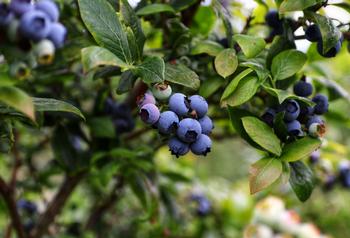Blueberry
-
Scientific NameVaccinium spp
-
General InformationBlueberries belong to the Ericaceae family, which includes azaleas and rhododendrons. They have pinkish flowers in the spring, berries in summer, and often brilliant red and yellow foliage in the fall.
 Photo by Mario Mendez
Photo by Mario MendezBlueberries have pinkish flowers in the spring, berries in summer and often brilliant red and yellow foliage in the fall.
-
When to Plant
In Marin, blueberries may be planted from fall through spring. Plants begin to bear at about three years and keep producing for 40 years.
-
Planting
Test and amend soil prior to planting. When ready to plant bare root stock or healthy two to four year old bushes, dig a hole one foot deep and twice as wide. Keeping plant high, spread roots in all directions and cover roots with soil, no more than 1-inch deeper than they were growing in the container. Firm soil around plants. Water thoroughly and mulch. Plant four to five feet apart depending on variety.
-
Soil Requirements
Blueberries like acidic, (pH 4.5-5.5) well-draining soil. Test soil prior to planting. Adding peat moss, elemental sulphur, or aluminum sulfate can lower soil pH about 1 point, for example from 6 to 5. Compost containing pine needles, coffee grinds and oak leaves will add organic matter and loosen up compacted soils, and may minimally help acidify soil. Reducing soil pH can take at least six months and up to one year. Note: The most effective approach is to add elemental sulphur over several years and monitor changes with annual testing. Aluminate sulfate is not recommended as it may be toxic to fragile blueberry roots and stunt growth.
-
Water Requirements
Blueberries have shallow root systems and need consistent water, especially when berries begin to swell. Plants need approximately one-inch of water per week and more during hot spells. Make certain drainage is good to avoid root rot.
-
Fertilizing
About one month after planting, apply 10-10-10 fertilizer – about one and a half tablespoons per plant. Reapply a balanced fertilizer in early spring or as needed throughout berry production season.
-
Pollination
Blueberries are not effective self-pollinators. For better quality berries and higher production, intermix at least two varieties (with similar bloom times) within five feet of each other. Bumblebees are the preferred pollinators of blueberries. They buzz or vibrate the blueberry flowers causing buzz-pollination. Native bees pollinate blueberries, too.
-
Harvesting
To determine ripeness of blueberries on the bush, move your fingers along the fruit cluster. Ripe ones fall off in your hands. After berries begin to turn blue, it’s about another week or so before the blueberry is truly ripe. The blue skin of the berry begins to look like it is covered in a film of gray fog.
-
Storage
Wash and completely dry blueberries before storing in a berry container in the refrigerator. Blueberries keep in the refrigerator up to two weeks.
-
Good Varieties for Marin
Southern high bush types are best suited to Marin.
Select those with lower chill hours:
‘Bountiful Blue’ ‘Sunshine Blue’ ‘Misty’ ‘Jubilee’ ‘Oneal’ ‘Chandler’
Older varieties that require about 500 hours of winter chill: ‘Early Blue’ ‘Blue Ray’ ‘Berkeley’ ‘Southmoon’Chill factor is the number of hours at which temperatures are between 32 to 45 degrees F over the course of an entire winter.
-
Helpful Tips
Protect blueberry bushes from birds using netting or a pop-up cage.
At planting time, prune back about 30%. Then for two to three years, plants require only light pruning to remove dead, twiggy or crossed canes. After the third year, prune blueberries annually, using caution to not cut back too much first year wood, which will produce fruit the upcoming season.
-
Common Problems
Blueberries have shallow roots. Mulch at least one-inch each year to maintain moisture balance and avoid weeds. Exclude birds with netting.
-
Pests- Diseases & More
Botrytis twig and blossom blight can be a problem in wet springs. Apply copper fungicide if wet weather persists. Insect pests are few. If aphids attack, hose them off. Thrips can be hosed off, too.
Learn more about growing blueberries.

